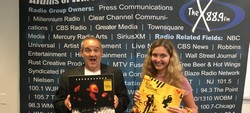WMCX is now running a weekly show which features music from vinyl records, as opposed to digitally downloaded MP3 files. The show, titled Side 1 vs. Side 1, airs Wednesdays at noon.
Hosted by Communication Department Chair Aaron Furgason, Ph.D, and WMCX intern Ainsley Vetter, Side 1 plays the first side of two different vinyl records which span across every genre and are picked at random.
A show like Side 1 requires an extensive, diverse catalog of vinyls, which did not necessarily appear overnight at WMCX. “The vinyl is a combination of a donation from Professor of Journalism John Morano as well as WMCX’s catalog and my own personal catalog,” said Furgason as he prepared an old turntable for the day’s show. The turntable in use is not property of the University, nor was it purchased by the station, but is actually from the Furgason’s days as a college DJ.
Morano, who made quite the generous donation to the station, started collecting vinyls at a young age. “The collection began when I was in junior high with the first albums I ever bought; Passion Play, by Jethro Tull; Catch Bull at Four, by Cat Stevens; and I Can See Clearly Now, by Johnny Nash,” says Morano, whose record collection would grow throughout high school and college. “There’s everything from The Dead to disco, and a lot in-between.”
However, Morano’s collection did not stop growing when he was handed his degree. During his days working in New York and Los Angeles as a critic and editor, Morano would find new records sitting on his desk daily. Many of them were from the biggest stars of the day, while others were from acts such as U2 or Prince who at the time were still up and coming. “The studios hoped I would listen to the albums, review them and maybe schedule an interview, or go to a concert,” recounts Morano.
“I’d often show up early to do interviews at the record companies. While I waited to chat with whomever, some wise PR person would bring me into a room and let me take whatever album interested me.” Under these circumstances, Morano’s collection would continue to expand in not only size but musical diversity as well.
Nonetheless, the professor was happy to make the donation of some 1,000 albums after Dr. Furgason told him about WMCX’s interest in vinyl, despite the collection’s longevity. “I had no reservations about parting with any of these albums,” said Morano. “I’m thrilled to share the music with the students at the radio station and their listeners. This collection is where it should be.”
Side 1 vs. Side 1 couldn’t have premiered at a more appropriate time; vinyl has come back in style in recent years. “Vinyl definitely has reappeared as something people wanna hold and touch and be a part of,” says Furgason, praising the medium’s sound quality. “The argument always is that Neil Young would tell you it’s warmer, it holds the notes, and it doesn’t compress it or speed it up like an MP3 does, so it’s the most natural sound you can get unless you actually heard it being recorded in the first place.”
Unlike other mediums such as compact discs (CDs) and cassette tapes, many consider vinyl to not only be another medium, but an almost completely different experience. “Vinyl has a sound and a personality that evokes an emotional response that cannot be replicated through a more digital format like MP3s,” says Jay Sweet, an Adjunct Professor of Music. “Besides the actual audio component, the act of selecting, unpacking, and putting on a record forces a listener to be more involved with the music.” According to Sweet, this direct and physical involvement with the vinyl makes listeners more active, aware, and responsive to what they are hearing. Though Professor Sweet was young during the takeover of CDs, a medium which also includes a selection process and visual component, he still feels vinyl comes out on top due to its sound quality which cannot be captured digitally; one may think this is why vinyl has made a comeback as opposed to the mediums that came after it. “For a good part of my youth, cassette tapes were the popular medium for listening to sound recordings. The transition from cassette to CD was both exciting and devastating, because of the money I had already invested in my collection,” recalls Sweet. “While there is definitely a certain nostalgia that I feel when thinking of these [other] formats, I do not believe they will make a comeback.”
Cassettes have followed in the footsteps of the 8-track tape in the sense that they are now obsolete. Former cassette users may recall the unreliability of the format as well; tapes would often get stuck in the spool and become damaged or destroyed. In addition to there being no sound-related benefits to collecting cassettes, the plastic casings they came in were also not environmentally friendly, according to Sweet. “In my opinion, vinyl is the only true audio delivery system worthy of return. Everything about a record, including the sound, size, cover art, length, and liner notes create an experience that cannot be replicated by other formats.”
Even so, vinyl’s resurgence may not entirely be due to a newfound appreciation for the medium. According to Mike Flannery, an Adjunct Record Production Professor. Many modern-day artists are deciding to press their music to vinyl, as they make for excellent band merch: “Records are collectible,” stated Flannery. “A band that only presses 500 copies of a record has created a rare object that, with any luck, will be talked about and sought after by fans for years to come.” This is a good marketing tactic for bands, as collectibles tend to run at higher values. This is why vinyl is higher priced than other types of media, which in the world of 2019, have depreciated in value if anything. “Because of streaming and the now ubiquitous idea that music is ‘free,’ it has gotten to the point where CDs and downloads of artists’ records have very little monetary value” says Flannery. According to him, many bands these days consider a CD to be almost equivalent to a business card; something to be handed out for free in an attempt to gain listeners and fans. “Fans who do buy the CD or download card are only doing so as a type of donation to support the band,” says Flannery.
The advent of streaming services has, in fact, changed the way people listen to music. With streaming placing more emphasis on singles and playlists, it can be easy to overlook the significance an album can have in the world of 2019. “It’s a crime to listen to only Estimated Prophet, but not the rest of the Grateful Dead album Terrapin Station; or The Real Me, but not the rest of The Who’s Quadrophenia,” says Morano. “There are so many examples that illustrate that an album can be greater than the sum of its parts. Vinyl reminds us of this over and over again and I’m thrilled that The X gets it.”
PHOTO COURTESY of Dr. Aaron Furgason



